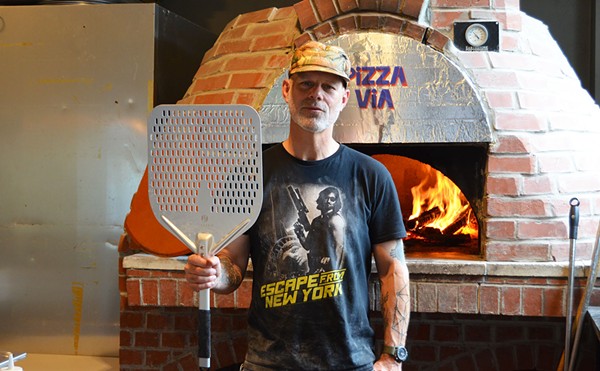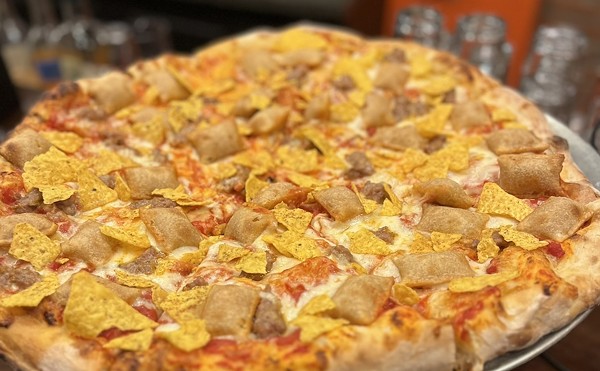Scherrer doesn't need his dad to run Arthur Clay's. He's had enough experience managing restaurants so that all Dad had to do was help renovate the former pizza and pasta joint known as Maria's, located at the confluence of Manchester Road and Southwest Avenue. Scherrer has opened and managed several restaurants: one in a Phoenix country club, one in a Florida hotel, a bistro in Providence (where he graduated from Johnson & Wales' culinary school). He also helped run Grenache soon after that erstwhile Clayton establishment opened. Scherrer's wife, Kerri, who also trained at Johnson & Wales (in classical French pastry arts), is the new restaurant's pastry chef.
Sometime during the restaurant's four-week existence, a Maplewood community paper tagged the food at Arthur Clay's as "French with an Asian influence." It's not a bad tag, but it's one Scherrer isn't enamored of. He trained mostly with French and Asian chefs, but, he says, "It would insult the French if I were to call this French food." The influences are, no doubt, present. It's been a long time since I've had foie gras, which was on Arthur Clay's menu one evening in the form of a terrine. As is common in the United States, this one was made with duck liver rather than the traditional goose, but never mind; laced with quince, gently pan-seared and flavored with honey and balsamic vinegar, the preparation was sublime. There was a lot going on in that small dish, but the flavors melded well, allowing the silky heft of the foie gras to dominate.
Entrée portions are on the small side, but the presentation is anything but modest. (In fact, we Americans are far too accustomed to servings that overflow the plate.) A mild striped bass was plated on stark white china, in a small pool of sweet-tasting Thai tomato broth with a side of sticky rice. Scherrer gets his seafood from a broker in Atlanta who, he says, "knows that I want fish the day it got out of the water." That bass, the owner later explained, was the result of a time-consuming cooking process in which a liquid made up of equal parts of soy sauce, honey, Champagne vinegar and grapeseed oil is basted over the fish until done.
But don't expect to find that same dish on the menu next week. If there's one signature item on Arthur Clay's menu, it's change. The roster is altered nearly every night, depending on what's available to Scherrer and his two assistant chefs, brothers Kent and Clay Dalton, who followed Scherrer from Destin, Florida. Scherrer says he wants to take advantage of the freshest ingredients possible. "Even if it's a great bunch of asparagus that came in," he says, "we have the ability to change the menu so that it doesn't get lost as a garnish on a piece of meat -- we can dedicate a dish to that beautiful asparagus." A refreshing attitude in a world where so many "high end" restaurants plate every single entrée with the same side vegetable.
Speaking of vegetables, though my party didn't partake, for $20 we could have reveled in a tasting that included roasted cauliflower soup, broccoli crostini, potato gnocchi, quince and a winter vegetable stew with star anise broth. Scherrer says that about five out of six nights, everything in his Vegetarian Tasting is vegan. (He may fold cheese into one of the dishes, so it's best to ask if the distinction is important to you.)
For carnivores, there was a thick hunk of venison on the menu one night and a beautiful rib-eye steak on another. Farm-raised in Colorado, the venison was far milder than that deer steak your buddy gave you a few months back. Nearly two inches thick, this tenderloin portion was pan-seared to medium rare and was as tender as any beef that has melted in my mouth. Topped with a savory seven-spice sauce and accompanied by house-made potato gnocchi, the dish made for a satisfying winter meal.
Scherrer buys dry-aged beef and then dry-ages it some more. Rib eyes are typically cut thinner than, say, a strip, but the kitchen nailed my request for medium rare. Dry-aging dehydrates the meat, making for a steak so concentrated in flavor that the accompanying bordelaise sauce seemed unnecessary. The side of ricotta-Asiago agnolotti proved the meal's sole disappointment -- there were only two stuffed pasta pillows, and they were mushy. When I spoke to Scherrer later, he brought up that dish as an example of how things don't always go right in the kitchen. He said the pasta hadn't set up properly, owing to a draft in the kitchen that made it difficult to keep the water at the boiling point. "I'd be lying if I said everything comes out perfect," he readily admits.
A duck entrée, consisting of a pan-seared breast and a confit leg, came out just fine. Both poultry elements were superb, the breast crisp outside and juicy within, the leg made flavorful from hours spent slow-cooking in its own fat. On one visit a creamy polenta was the accompanying starch; a week later it was potato gnocchi.
Kerri Scherrer and Paul Hayden (the latter is the general manager of the Wine & Cheese Place) constructed Arthur Clay's wine list with an eye toward expansion. Of more than three dozen reds, a third are labeled "Interesting Reds," while the rest are split among cabs, merlots and pinot noirs. (Finally, a wine list that offers more than one zinfandel -- four, to be exact.) Ten reds are offered by the glass, ranging from $7 to $12. The whites are less varied. Though no fewer are "Interesting," there's an overabundance of chardonnay (thirteen in all). Nine whites come by the glass ($6 to $11). Five selections comprise the sparkling/Champagne category, with only the ubiquitous Freixenet Cordon Negro offered by the personal-size 175-milliliter bottle. Schlafly beers are on tap, and there are six from which to choose. A full array of dessert wines is available as well, including a luscious Campbell's Tokay ($30 per bottle), recently written up in a New York Times article on Australian "stickies."
Should you prefer eating your dessert, Kerri Scherrer offers a rotating selection of three. Notable were a marvelous caramel apple cheesecake, light and nearly mousse-like, with a spicy gingersnap crust, and a dense, delicious chocolate caramel tart further enhanced with a small scoop of chocolate ice cream.
She also designed the restaurant's interior, with the assistance of some friends and a computer program. Simple and clean-cut was the desired look. "I do not want to be considered fine dining," Steve Scherrer states emphatically. From the curvy partition of the hostess station to the poured cement bar to the exposed brick walls, the interior is sleek yet warm. Add a fireplace and this would be one cozy spot from which to watch snow falling. One quibble would be the chrome-and-white-vinyl barstools: One misgauged attempt climbing onto one and you may find yourself rediscovering those instant reflexes you thought lay dormant.
Arthur Clay's is the latest addition to the growing Maplewood "scene" (if one can say that with a straight face). But with Monarch and Maya Café at one end of Manchester and the Schlafly bottling plant (and, soon, restaurant) at the other end, the area is rapidly becoming a dining destination. Scherrer has chosen his location wisely, and he's occupying it well. His dad ought to be proud.





